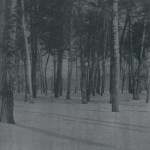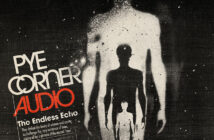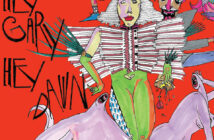
I suppose I should give this collaboration between Belgian visual artist Sylvestre Gobart and French musician (and in this case, sound-recordist) Stéphane Garin its exhaustive full title “Gurs, Drancy, Bobigny’s train station, Auschwitz, Birkenau, Chelmno-Kulmhof, Majdaneck, Sobibor, Treblinka.” Phew; and it’s an exhaustive listening experience, as extreme, in its own way, as the pure digital sine wave manipulation of my previous review of Cyclo. Gurs…Treblinka consists of unmixed, unmolested field recordings; the sound of everyday life and nature combining, in an attempt to reconfigure and decontextualize the powerful historical memories of the atrocities committed by Nazi Germany during the Second World War. I’m in the habit of zeroing in almost solely on the audio component of a release, maybe with a perfunctory comment about the cover art or tactile nature of the packaging, if this seems relevant. In the case of Gurs Treblinka, I needed to treat the package as a coherent whole, pawing over the zinc-saturated grey scale images of the various locales in order to link the visual and audio components of the work. Gobart’s photography has a solemn and steely feel to the reproductions contained within on CD-sized individual pages.
Gobart and Garin chose not to record at the central, obvious location at the different sites, rather detouring to a forgotten glade or peering over a wall constructed after WWII, in order to demonstrate that life must go on. The extermination camp at Sobibor in far-eastern Poland, is represented by sounds of heavy machinery, tools being dropped, idling motors. The visual side shows a heavily laden train and a sandy track torn asunder by heavy tyre-tracks. A place of Jewish pilgrimage, Chelmno-Kulmhof was another Nazi camp in Poland. Garin’s field-recordings include subdued voices, crunching footsteps in the snow and a distant, somewhat haunted, yet hopeful song of redemption.
The artists state their desire to break with the dominant iconography of the Holocaust, replacing the collective memory of dank gas chambers and mass graves with a new psychogeography of the locales involved in an intensely dark chapter of human existence. Without wanting to trivialise the subject matter, or the artistic intention behind the Gurs. Treblinka project, the audio component did nothing to hold my attention. Rather, I slumbered and re-awoke to certain passages throughout the nearly two-hour duration of the double CD album. As an interdisciplinary artistic statement, Gurs Treblinka carries a powerful emotional punch; it’s just not something I’m particularly inviting of into my life. Garin and Gobart demonstrate an unmistakable self-belief in their approach. Admittedly, my relationship with field-recordings is somewhat ambivalent, and my tastes veer towards the more heavily processed end of this audio niche, but even with some heavy contemplation on a blackened past, Gurs Treblinka was, for this reviewer, an exercise in patience that was ultimately unrewarding. Find out for yourself here.
Oliver Laing



